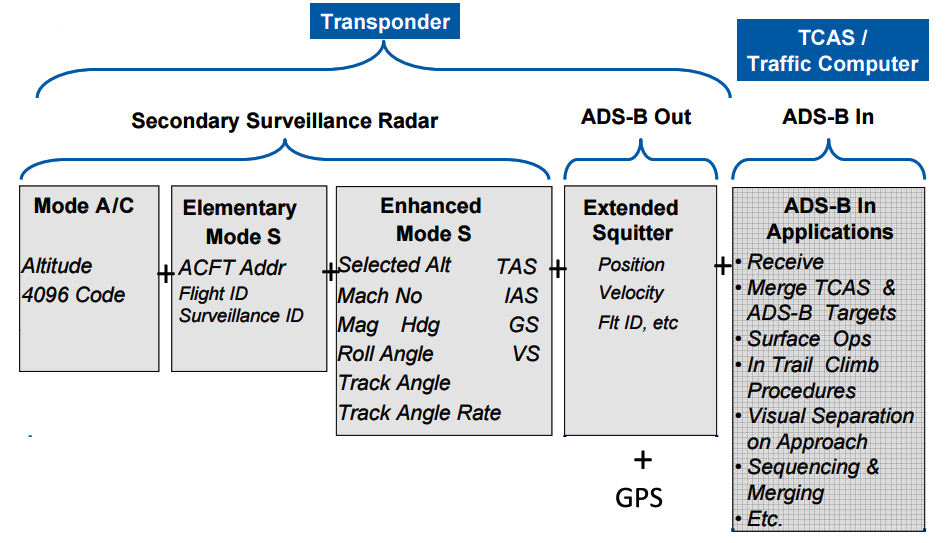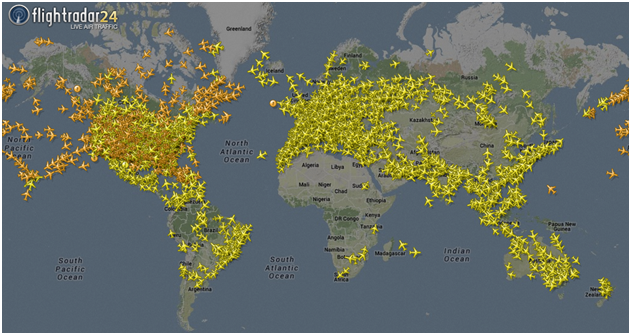Leeham News and Analysis
There's more to real news than a news release.
Bjorn’s Corner: Transponders, the kingpin of safe air navigation, Part 2
May 27, 2016, ©. Leeham Co: In last week’s Corner, I started to describe how the aircraft Transponder grew out of the military IFF and how it gradually became a very important part of current Air Traffic Management (ATM).
We will now dwell deeper on the most capable transponder type, the mode S type. We will describe how this is available in versions which give Air Traffic Controllers (ATC) info on what the airliner is doing and how it’s further developed from an aid for air navigation to be the kingpin for all future air navigation.
Figure 1 shows a classical transponder how most General Aviation and Commuter aircraft pilots know them, a narrow panel in the avionics stack. In airliners they are more integrated into the overall cockpit concept but their functionality is the same.
How the transponder developed to be the primary tool for safe air traffic is a bit involved, but we will take it in steps.
Mode S transponders
In last week’s article, we described how transponders responded when a Secondary Surveillance Radar (SSR) swept over the aircraft and sent interrogation pulses. The advantage was that the Transponder’s response back to the SSR was stronger than a normal Radar return and it contained the aircraft’s Squawk number for type A transponders (the four-digit code the ATC asked you to respond with) and the altitude in 100ft increments in addition for mode C transponders.
A more capable transponder is the mode S type. It can, in addition to the four-digit Squawk code, respond to a unique 24-bit aircraft address, thereby eliminating the problem of Squawk code shortages for congested areas. Mode S also has several additional capabilities depending on model.
Figure 2 is an edited picture that I have taken from a Rockwell Collins presentation. It gives a good overview of different Transponder types and what they can do. We will now explain the capabilities of each model and what it’s good for.
In an Elementary Mode S transponder (boxes one+two), it adds the flight’s call sign and the interrogating SSR’s ID (Surveillance ID) to the response. This makes sure the ground station knows the response is to his interrogation.
Eurocontrol (controlling Europe’s airspace) has demanded that all aircraft over 5700kg carry an Enhanced Mode S transponder. This adds the FMS selected altitude, Mach, Heading and much more information to the response (boxes one+two+three). With this, the European Air Traffic Controllers (and their systems) can read the aircraft’s keyed in altitude, its speed, heading etc. This enables a much safer and more optimal control of the air traffic.
The Mode C and S transponders also respond to other aircraft which are equipped with Traffic Collision Avoidance Systems (TCAS). These aircraft continuously interrogate their direct environment for other transponder-equipped aircraft. Based on overall direction and range to the responding aircraft and how this changes over time, the TCAS computer can determine if there is a collision risk or not. If there is, the TCAS warns for a collision risk (TCAS I, for light aircraft) and advises action (TCAS II, for airliners).
From transponder to position beacon
The really important step in the chain is the ADS-B step. ADS-B-capable transponders are gradually being introduced for all aircraft flying in controlled airspace in the US and Europe, with latest date 1 Jan 2020 in US and 1 June 2020 in Europe. The transponder now goes from a responder to interrogations to a continuously sending beacon (ADS-B out), broadcasting its 3D position and velocity (and a lot of other information) to anyone who will listen (Extended Squitter means extended burst capability to send out such info). The aircraft’s 3D position and velocity is taken from an augmented GPS receiver in the aircraft.
Everything change with ADS-B
Once every aircraft is flying around and sending its complete info package to everyone else, whether on ground or air, the whole air traffic surveillance situation changes. It’s now possible for every receiver on ground and in the air to follow and predict the future position of every aircraft within its reception capability.
We will describe the consequences of all this in more detail in the next corner, where we will also go through ADS-B In and ADS-B based TCAS (Traffic Collision Avoidance System) applications. For now, we will describe the most known consequence of ADS-B, Flightradar24.
As all that is required to track aircraft is an ADS-B receiver and a computer program to sort the data and do the calculations, all sorts of utilizations are possible. One is Flightradar24 (FR24), which started as an enthusiast movement to track air traffic. It has today developed to where it has taken on professional dimensions (even the aircraft OEMs use FR24 to follow their aircraft the world over).
FR24 builds on that ADS-B capable receivers could be owned by everyone and be made available for as low as $100 (or even less). Coupled to a computer with adapted software in the enthusiast’s home, it conveyed the position of the aircraft in its reception area over internet to FR24 servers.
Gradually the World Wide coverage of FR24 improved. Today it covers most land areas and is complemented with other tracking methods where it has no ADS-B receiver coverage, Figure 3
To increase the tracking reliability and increase the coverage further, FR24 now sends out receivers and antennas free of charge to people who will extend their coverage. The boxes they send contain their own computer and GPS receiver (to get accurate time stamps).
The only thing required by the enthusiast is to couple the box with Ethernet to the household router and put the antenna on the roof or balcony. The box will then collect broadcasted ADS-B info from all aircraft in its reception area and send that to the FR24 servers. As a thank you for this service, the box owner will get a free FR24 pro (add free) subscription.






The transponder in MH370:
http://tinyurl.com/gqpnwcn
http://tinyurl.com/or9bzf2
As these standards and rules change, how exactly do they get deployed to an airline fleet? Is it only new aircraft that the rules apply to, or do they get retrofitted too? For retrofits who develops the updated avionics (the information needs to come from somewhere) and who has to pay for all this?
To answer from the bottom up. The operator pays for any retrofit installation. This type of equipment is developed by the major avionics vendors, Honeywell or Rockwell Collins to name two. The installation in an existing aircraft may be developed and certified by the aircraft OEM and published as a Service Bulletin or an independent developer as a Supplementary Type Certificate installation. Either national or regional civil aviation authorities force the adoption through operating rule changes. For new aircraft the equipment is normally fitted as standard production installation.
What surprises me is that aircraft don´t get a comprehensive transponder requirement until 2020 but ships have had it since about 2005. (called AIS)
Ships have also had to transmit position/course/ speed data via satellite for several years but nothing make its way through the ICAO.
Bjorn,
Great piece on transponders. By the way, have you seen this:
http://www.king5.com/tech/science/aerospace/boeing-enhances-air-safety-with-upgraded-display-for-pilots/216240419
Sort of changing IMC to VMC.
Hi Andy,
interesting. The report say one day we might fly with full synthetic vision, well we are, on Biz jets. Its typical that its not the league 1 which is forming the future in avionics but rather the lower echelons. I have experienced the same trends in other industries, the most innovative layers are those who have a more competitive environment. Garmin is chasing Rockwell Collins and Honeywell in these markets and this drives innovation.
Tack for svar. Are there systems today that offer full synthetic vision? Sort of like feeding the views available on crew training simulators to HUDs? Maybe a topic for an article?
As an aside, there are cars today with HUD for speed and nav info and separate IR based night vision systems.
It’s available from the leading avionics companies for GA and Biz jets, here is one version:
Rockwell Collins Synthetic Vision system